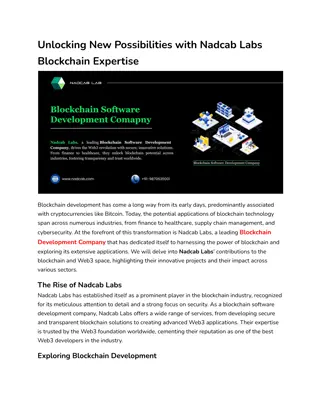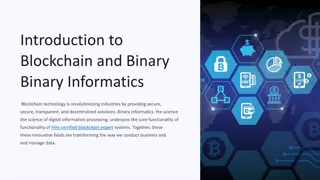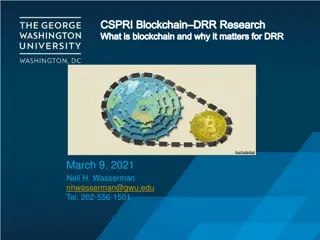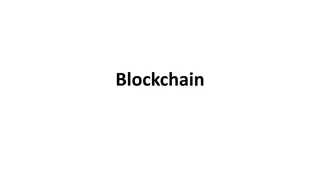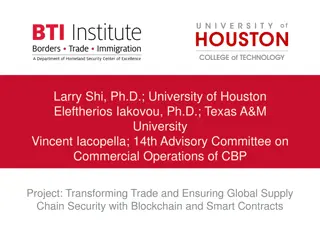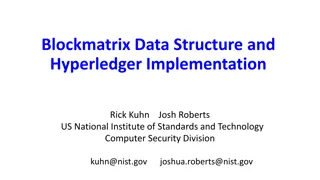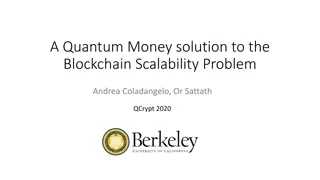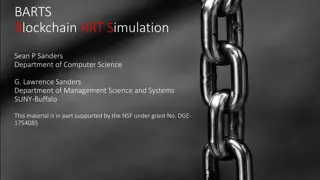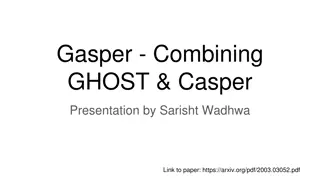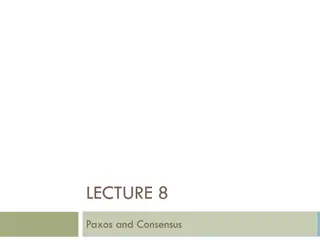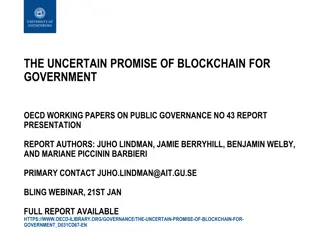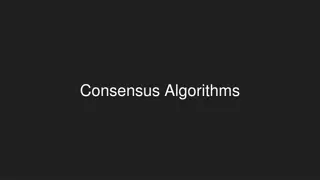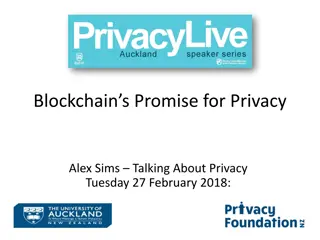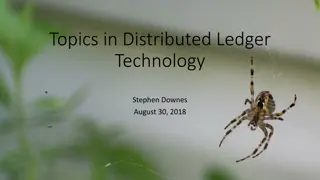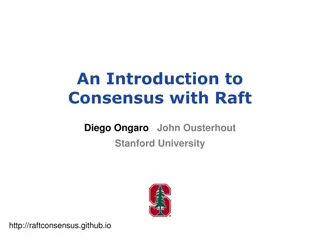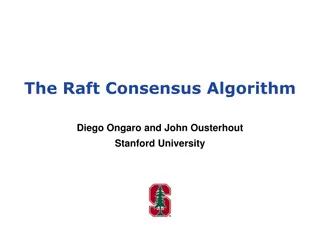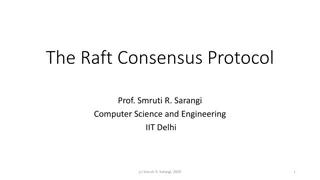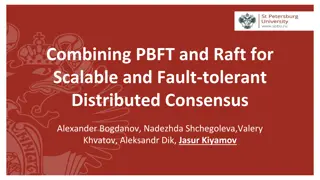Understanding CS 394B: Blockchain Systems and Distributed Consensus
This course, led by Assistant Professor Marco Canini, delves into the technical aspects of blockchain technologies, distributed consensus, and secure software engineering. Students will engage in flipped classroom-style classes and paper presentations, critiquing research papers, defending research approaches, and moderating discussions. The instructor's research spans formal methods, distributed systems, security, machine learning, and more, aiming to build scalable and dependable networked systems. Challenges of system complexity are addressed through a systems approach, emphasizing problem formulation, prototyping, measurement, analysis, and adjustment based on foundational principles.
- Blockchain Systems
- Distributed Consensus
- Secure Software Engineering
- Research Critique
- Scalable Systems
Download Presentation

Please find below an Image/Link to download the presentation.
The content on the website is provided AS IS for your information and personal use only. It may not be sold, licensed, or shared on other websites without obtaining consent from the author. Download presentation by click this link. If you encounter any issues during the download, it is possible that the publisher has removed the file from their server.
E N D
Presentation Transcript
CS 394B Introduction Marco Canini CS 394B S18 1
This Class Course is a combination: classes in a flipped classroom style and paper presentations/discussions Learn technical aspects of blockchain technologies and distributed consensus Have the conceptual foundations to engineer secure software that interacts with the blockchain Be able to integrate ideas from the blockchain in their own projects Comprehend and critique relevant research papers in the area of blockchain systems Present research ideas both orally in a concise way and within the allotted time as well as in writing Defend the research approach, design decisions, and the evaluation methods in a discussion Moderate a discussion after a research presentation CS 394B S18 2
About the Instructor Marco Canini Assistant Professor at KAUST since Aug 16 https://mcanini.github.io Research interests span Distributed and Networked systems in the context of cloud computing, large- scale data analytics, and machine learning Head of SANDS Lab Software-defined Advanced Networked and Distributed Systems Laboratory CS 394B S18 3
My research Formal Methods Distributed Systems Security Machine Learning Optimization Theory Networking Software Engineering Programming Languages I design, build, measure and analyze large-scale networked systems that span multiple autonomous, potentially untrusted entities Goal: Discover and apply fundamental principles and valuable knowledge on how to build scalable, dependable and future-proof systems, worthy of society s trust CS 394B S18 4
Challenges #1 Challenge: Complexity Hard to reason about behavior as systems scale to large numbers of components and users Poorly understood connections Need predictability to ensure scalable performance, reliable operation, etc. CS 394B S18 5
Systems Approach Formulate problem Get idea Build prototype Measure & analyze Adjust prototype repeat previous step Principles of system construction modularity, hierarchy, layering, abstraction, end to end CS 394B S18 6
New approaches are needed Systems based on design decisions made in the last decade can hardly cope with today s scale, volume or velocity, let alone the future We need new techniques, designs and solutions: Improve performance by at least 10x, in some cases 100x Ensure predictability of performance and high reliability Lower complexity of managing large-scale systems and processing big data CS 394B S18 7
SANDS Lab Vision Make it easy to produce and manage key networked systems that are worthy of society s trust and achieve specific objectives: High performance and scalability High dependability and future-proof Low power We build prototypes that directly improve the lives of real users We learn general principles and lessons of what works in practice CS 394B S18 8
Example: Dynam-IX Dynamic Interconnection eXchange https://dynam-ix.github.io/ CS 394B S18 9
What About You? Please introduce yourself! Why are you in this class? How can we make it a very useful one? CS 394B S18 10
About this class CS 394B S18 11
Course Schedule Webpage: http://web.kaust.edu.sa/Faculty/MarcoCanini/classes/CS394B/S18/ Piazza: https://piazza.com/kaust.edu.sa/spring2018/cs394b Meetings 4PM 5:30 PM (Sun for lectures and discussions) Pay attention to the online announcements and schedule On average, one meeting per week Makeups will be added on a need-to-add basis, typically Wed CS 394B S18 12
Prerequisites CS 240 (Computing Systems and Concurrency) Basics of OS organization, threads, memory management, file systems, scheduling, networking, etc. Equivalent course of CS 240 is acceptable as well Good programming skills Distributed systems helpful Cryptography helpful Probability helpful CS 394B S18 13
Flipped classroom Course lectures are online We follow the course Bitcoin and Cryptocurrency Technologies by Arvind Narayanan, Joseph Bonneau, Edward Felten and Andrew Miller http://bitcoinbook.cs.princeton.edu/ You must watch the video material before the meeting We go deep into each topic during meetings Send me questions in advance regarding the material CS 394B S18 14
Textbook Textbook not required but can be very helpful Arvind Narayanan, Joseph Bonneau, Edward Felten, Andrew Miller and Steven Goldfeder, Bitcoin and Cryptocurrency Technologies A pre-publication draft of the book is available for download on the website: http://bitcoinbook.cs.princeton.edu/ CS 394B S18 15
Course Requirements Paper Reviews Paper Presentation Active Participation Assignments Project 15% 15% 5% 25% 40% Checkpoint #1: initial proposal 5% Checkpoint #2: midterm progress report Presentation 10% 10% Final report 15% CS 394B S18 16
Paper Reviews Paper reviews account for 20% of the total grade 6-8 summaries to write What goes in a good summary? Highlight strengths Highlight weaknesses Describe the entire paper in 3-5 sentences CS 394B S18 17
Papers Read critically! Is the problem real? What is the solution s main idea (nugget)? Why is solution different from previous work? Are assumptions different? Is workload different? Is problem new? Does the paper (or do you) identify any fundamental/hard trade-offs? Do you think the work will be influential in 10 years? Why or why not? CS 394B S18 18
Paper Reviews Reviews must be submitted electronically 24 hours before the class Send the review via Piazza as private note to Instructors You can miss at most two without any penalty Each missing one beyond that will result in 25% decrease in grade for this segment Meaning, missing six or more will result in 0% for the Paper Reviews segment of your grade Reviews are peer-reviewed Another student will read and give constructive feedback on your review The goal is to make better reviews Good feedback will be considered positively during grading Read (if you haven t already!) How to Read a Paper by S. Keshav How to read a research paper by Michael Mitzenmacher Writing Reviews for Systems Conferences by Timothy Roscoe CS 394B S18 19
How to Review You will see a section for describing a paper summary, its strengths, its weaknesses, and detailed comments In the summary section, please directly address: 1. What problem the paper is addressing (1-2 sentences or bullets) 2. The core novel ideas or technical contributions of the work (1-2 sentences or bullets). Put another way, what's the 30 second elevator pitch, or, five years from now, what should one remember about this paper? 3. A longer description (3-5 sentences) that summarizes the paper's approach, mechanisms, and findings. For the other sections, please include 2-4 bullet points for the strengths and weaknesses, while a much longer exposition in the detailed comments. Remember to be constructive: don't only focus on the paper's shortcomings, but also on what it could have done differently or as the next steps. Imagine that you are having a conversation with the authors: What would you tell them? CS 394B S18 20
Paper Presentation Each student must present at least two papers; possibly three Paper presentation account for 15% of the total grade Two papers per class and 20-minutes presentation for each Sharp 20 minutes; we start clapping! Followed by discussion anchored by the presenters What should go in a useful presentation? Motivate Highlight the key ideas and insights; skip the details Lead the discussion Go through the strengths and weaknesses from the paper review CS 394B S18 21
Presentation Guidelines Your oral description of the paper should follow a much similar format: 1. Title, authors and institutions, conference/journal 2. Problem 3. Core ideas 4. Descriptive summary and main results 5. Strengths 6. Weaknesses/limitations 7. Further discussion, including proposals for follow-up work CS 394B S18 22
Paper Presentation Email your slides to the instructor 24 hours before the class Prepare early Practice a lot Also, read How to Give a Bad Talk by David A. Patterson Pointers for Leading Paper Discussions by Randy H. Katz CS 394B S18 23
Participation Attend all meetings Can miss at most two with legitimate reasons Read all the papers and participate Ask questions! Send questions on video lectures (in advance) CS 394B S18 24
Assignments 3 programming assignments To be done individually; due 11:59pm on due date 11/2 Assignment 1 due 28/2 Assignment 2 due 21/3 Assignment 3 due No extensions given CS 394B S18 25
Project The biggest component of this course Pick an interesting open problem. Why is it important? What has already been done? Why are they not enough? Develop a hypothesis about how you d improve it Intuitively, why will your approach work? Build a substantial prototype Experiment, measure, and compare against the state-of-the-art Aim at producing a conference/workshop-quality research paper Can be related to your research topic but it is expected to be distinct! CS 394B S18 26
Projects The final project accounts for 40% of total grades Done in groups of 2 students. Find your peers! What can and cannot be a project? Just surveys are not allowed. In fact, each project must include a survey of related work and background An ideal project should answer the questions you asked during paper reviews and points you cared about for presentations Measurements of new environments or of existing solutions on new environments are acceptable upon discussion Will cover projects in more depth in the next meeting! CS 394B S18 27
How to Approach it? 1. Find a problem and motivate why this is worth solving 2. Survey background and related work to get a sense of your (friendly!) competition Might require you to go back to the first step 3. Form/update your hypothesis 4. Test your hypothesis Go back to 3 until you are happy 5. Present your findings in a presentation and in writing Discuss known limitations CS 394B S18 28
Milestones Date Milestone ASAP Form Group Details Find like-minded students 14/2/18 Draft Proposal Send your proposal by email Finalize Proposal Checkpoint #1 (5%) 7/3/18 After a back-and-forth discussions with the instructor Midterm Progress Report Checkpoint #2 (10%) 21/3/18 Should read like parts of a research paper Define and motivate a problem, survey related work, and form initial hypothesis and idea 25/3/18 Midterm Presentations 13/5/18 16/5/18 Presentations (10%) Research paper (15%) Present your findings in a presentation Submit a final report similar to the papers you read CS 394B S18 29
Draft Proposal Two pages including references that ideally includes What is the problem? Why is it important to solve? Any initial thoughts on what you want to do? How would you evaluate your solution? Include team members Meaning, form a group ASAP Schedule via email a 15-minute meeting to discuss Read: The Heilmeier s Catechism CS 394B S18 30
Finalized Proposal Two pages including references that must include What is the problem? Why is it important to solve? Any initial thoughts on what you want to do? How would you evaluate your solution? Approved by the instructor and agreed upon by you Forms the basis of expectation CS 394B S18 31
Midterm Presentation In-class short presentation over one day This is to make sure you are making progress Must include What is the problem? Why is it important? What are the most related work? What s your hypothesis so far? How are/will you evaluate it? CS 394B S18 32
Final Presentation and Paper Presentation It will follow a format similar to other presentations given in the class Research paper The key part Should be written similar to the papers you ve read Your goal is to do publishable quality systems research Up to five best projects will be earmarked for expedited submission to a renowned conference, with the help of the instructor How to Write a Great Research Paper by Simon Peyton Jones CS 394B S18 33
Rough Outline Abstract Introduction (Highlight the importance and give intuition of solution) Motivation (Use data and simple examples) Overview (Summarize your overall solution so that readers can follow later) Core Idea (Main contribution w/ challenges and how you address them) Implementation (Discuss non-obvious parts of your implementation) Evaluation (Convince readers that it works and when it fails) Related Work (Let readers know that you know your competition!) Discussion (Know your limitations and possible workarounds) Conclusion (Summarize and point out future work) CS 394B S18 34
Course Topics Introductory material (~10 video lectures) basics of cryptography; Merkle tree blockchain; distributed consensus mining; incentives proof of work; proof of stake governance; economics security smart contracts; applications Advanced material active research problems in the area, including attacks, network scalability, alternatives to proof of work/stake CS 394B S18 35
Before We Move On No extensions Everyone must watch lectures and read papers in advance Class meeting format Quick summary by the instructor Topic discussion and addressing questions Presentation of one paper Presenters lead discussions on the papers we ve read and related topics CS 394B S18 36
Developing a Cryptocurrency CS 394B S18 37 Slide courtesy of Ittay Eyal
Bitcoin 2008: The Bitcoin white paper 2009: Reference implementation Probably not this guy CS 394B S18 38 Slide courtesy of Ittay Eyal
Key Challenges B A C 1. No stealing: Only Alice can move her money 2. Minting: Fair money creation 3. No double-spending: Alice cannot duplicate her money CS 394B S18 39 Slide courtesy of Ittay Eyal
60 Seconds on Public Key Signatures Alice generates key pair 1. private key ??, kept secret 2. public key ??, published with public key infrastructure Alice signs a message ? with private key ??, generating a signature ?. Anyone can verify that ? is a signature of ? with key ?? given ? and ??. CS 394B S18 40 Slide courtesy of Ittay Eyal
Addresses and Transactions 1. ??, amount 0.5? 2. ??, amount ? 1. sgn(??) 2. ??, amount ? 2. sgn(??) 1. ??, amount ? 3. ??, amount 0.5? CS 394B S18 41 Slide courtesy of Ittay Eyal
Key Challenges B A C 1. No stealing: Only Alice can move her money 2. No double-spending: Alice cannot duplicate her money 3. Minting: Fair money creation CS 394B S18 42 Slide courtesy of Ittay Eyal
Global Ledger M A A B B C CS 394B S18 43 Slide courtesy of Ittay Eyal
Global Ledger M A A B A C CS 394B S18 44 Slide courtesy of Ittay Eyal
Global Ledger M A A B B C CS 394B S18 45 Slide courtesy of Ittay Eyal
Key Challenges B A C 1. No stealing: Only Alice can move her money 2. No double-spending: Alice cannot duplicate her money 3. Minting: Fair money creation CS 394B S18 46 Slide courtesy of Ittay Eyal
60 Seconds on Cryptographic Hashing Lorem ipsum dolor sit amet, consectetur adipiscing elit, sed do eiusmod tempor incididunt ut labore et dolore magna aliqua. Ut enim ad minim veniam, quis nostrud exercitation ullamco laboris nisi ut aliquip ex ea commodo consequat. Duis aute irure dolor in reprehenderit in voluptate velit esse cillum dolore eu fugiat nulla pariatur. Excepteur sint occaecat cupidatat non proident, sunt in culpa qui officia deserunt mollit anim id est laborum. Hash Function ? 56293a80e0394d25 2e995f2debccea82 23e4b5b2b150bee2 12729b3b39ac4d46 256 bit number (for example) String input Given a 256bit number , one cannot find an input string that results in faster than repeatedly guessing inputs ? and calculating ?(?). CS 394B S18 47 Slide courtesy of Ittay Eyal
Mining Mining Minting for Proof of Work Computationally difficult puzzle: Find ? such that ? ?|? < ? Solver guesses values for ? until finding a valid one Different strings ? for different puzzles The target ? determines the difficulty, average time to solve CS 394B S18 48 Slide courtesy of Ittay Eyal
Mining Mining Minting for Proof of Work puzzle solution (PoW) A CS 394B S18 49 Slide courtesy of Ittay Eyal
Key Challenges 1. No stealing: Only Alice can move her money Cryptographic signatures 2. No double-spending: Alice cannot duplicate her money Global ledger 3. Minting: Fair money creation Mint for proof of work CS 394B S18 50 Slide courtesy of Ittay Eyal



